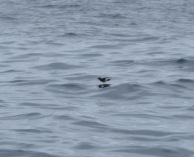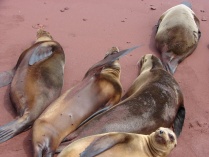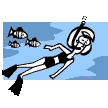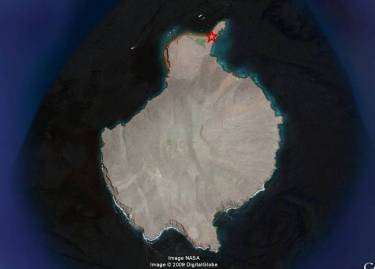Route map (click on map for a larger version)
(click on map for a larger version)
(Note: To skip the text, you can see the photos and brief descriptions of the wildlife on Rábida and Bartolomé here; click on any photo to see a larger version.)
Saturday, 9/12, morning
While sitting in the lounge, waiting for the breakfast bell, I spotted some acrobatic birds that seemed to be dancing on the water  just alongside the boat. At one point, with a group of probably more than 30, they looked like butterflies “puddling” on an early morning. These were Elliot’s Storm-Petrels. The derivation of their name is interesting. “Storm” refers to the fact that they often fly in large swarms, like a “storm” of birds. “Petrel” refers to the biblical Peter’s walking on water, drawn from their tendency to hover over the water with the legs hanging down—it almost looks like they’re walking on the water. You can see this a bit in this photo. (You’ll definitely need to click on the photo for the larger version.) It was a rare morning that we didn’t have a “storm” of these little imps flashing the small white bands across their tails and “walking on water” while we awaited breakfast.
just alongside the boat. At one point, with a group of probably more than 30, they looked like butterflies “puddling” on an early morning. These were Elliot’s Storm-Petrels. The derivation of their name is interesting. “Storm” refers to the fact that they often fly in large swarms, like a “storm” of birds. “Petrel” refers to the biblical Peter’s walking on water, drawn from their tendency to hover over the water with the legs hanging down—it almost looks like they’re walking on the water. You can see this a bit in this photo. (You’ll definitely need to click on the photo for the larger version.) It was a rare morning that we didn’t have a “storm” of these little imps flashing the small white bands across their tails and “walking on water” while we awaited breakfast.
This morning was the first snorkeling adventure for the group. Right after breakfast, we gathered on the fantail of the boat and Carlos brought out the boat’s equipment store of masks/snorkels and fins. A few people had brought their own masks/snorkels, although I think everyone used the boat’s flippers. Once we were all outfitted, we plunked our gear in the net bags and worked very hard to remember the number on the tag of the bag. That bag would be ours for the duration of the trip. Carlos even taught us a nifty knot that made it easy to remove the bags from their hanging rod. Z (a.k.a. “knot boy”) picked it up immediately; I had to practice it many times and over many days—but I eventually got it. I knew I had succeeded when I hung up Z’s bag without his knowing it; he thought that Carlos had done it. Score!
We took our gear bags with us as we jumped in the pangas to head to the beach. Rábida  is named after a convent in Spain, whose prior was instrumental in obtaining the support of Spain’s Queen Isabella for Christopher Columbus’s voyage to the new world. The beach at Rábida is a surprising dark red. This color comes from scoria—a particulate material created when hot lava meets sea water—which is high in iron. Like most cinder cones, the cone to the west has eroded more easily than other types of volcano cones, and Rábida’s red sand beach has resulted from the erosion of this cinder cone. You can see this red sand in this photo of the seemingly omni-present Galápagos sea lions lounging on the beach.
is named after a convent in Spain, whose prior was instrumental in obtaining the support of Spain’s Queen Isabella for Christopher Columbus’s voyage to the new world. The beach at Rábida is a surprising dark red. This color comes from scoria—a particulate material created when hot lava meets sea water—which is high in iron. Like most cinder cones, the cone to the west has eroded more easily than other types of volcano cones, and Rábida’s red sand beach has resulted from the erosion of this cinder cone. You can see this red sand in this photo of the seemingly omni-present Galápagos sea lions lounging on the beach.
We dropped our gear bags at one side of the beach and headed out for a short walk. (The red star on the Google Earth map at the top of the page shows our general area.) Lots of new species emerged here: Nazca Booby, Galápagos Hawk (the lone buteo species—or any raptor species, for that matter—on the islands), Galápagos Dove, Galápagos Mockingbird, Small and Large Ground Finches. Two non-new species, Wandering Tattler and American Oystercatcher, appeared along the beach. Compared to the birds on the later islands, these birds were all pretty skittish and difficult to photograph. (The sea lions, of course, were not.) To be honest, I don’t remember all that much about this particular walk, because I was rather anxious about snorkeling for the first time in 3 decades.
And it was a challenging first attempt, I must say. Z unknowingly demonstrated for the group the trick of walking backwards into the water, to keep the flippers at least vaguely under control. The water was COLD! (A few folks had their own wet suits, which would be especially useful in later days, in the more southerly islands where the water was even colder. And Carlos always wore a full wet suit when snorkeling, interestingly enough—especially since he almost never wore shoes on the walks.) I eventually plunged in, fearing group ridicule if I dawdled much longer. I first tried just leaping into the act of snorkeling as if I were an old pro. However, such bravura did not fool myself. I had a bit of a panic attack around breathing through the snorkel. I was fine doing it while standing in the water with my face submerged. So obviously, I understood the mechanics of it all. But once I started to float, the panic ensued, primarily evidenced through hyperventilation. Yet I knew I had snorkeled before and I was darn certain I was going to do it again, although that resolve did nothing to help with the panic. After a few of my futile tries, Z offered to just stand still and hold me while I floated and got the hang of it. Worked like magic! After just a few minutes, I signaled that I was ready to try moving. He continued to hold my hand as we kicked along the shoreline, which was both reassuring and great fun. Since I wasn’t all the comfortable looking all around under water yet, he was able to easily signal to me to look at some specific interesting fish or structure or ray or whatever.
to keep the flippers at least vaguely under control. The water was COLD! (A few folks had their own wet suits, which would be especially useful in later days, in the more southerly islands where the water was even colder. And Carlos always wore a full wet suit when snorkeling, interestingly enough—especially since he almost never wore shoes on the walks.) I eventually plunged in, fearing group ridicule if I dawdled much longer. I first tried just leaping into the act of snorkeling as if I were an old pro. However, such bravura did not fool myself. I had a bit of a panic attack around breathing through the snorkel. I was fine doing it while standing in the water with my face submerged. So obviously, I understood the mechanics of it all. But once I started to float, the panic ensued, primarily evidenced through hyperventilation. Yet I knew I had snorkeled before and I was darn certain I was going to do it again, although that resolve did nothing to help with the panic. After a few of my futile tries, Z offered to just stand still and hold me while I floated and got the hang of it. Worked like magic! After just a few minutes, I signaled that I was ready to try moving. He continued to hold my hand as we kicked along the shoreline, which was both reassuring and great fun. Since I wasn’t all the comfortable looking all around under water yet, he was able to easily signal to me to look at some specific interesting fish or structure or ray or whatever.
 The water still felt cold at the end, although not unbearably so. One panga moved along with the group, in case anyone needed anything; the 2nd panga went to the point at which we were to turn around. I don’t really remember any details of what we saw—I know pretty much less than nothing about fish species—but many were very colorful and pretty. (We had a retired marine biologist in our group. I’m sure he would be appalled at that description.) We even had a few sea lions moving around us in the water, which was both very startling and kind of fun. All in all, we probably were only in the water about 30 minutes, but it was a triumphant 30 minutes for me.
The water still felt cold at the end, although not unbearably so. One panga moved along with the group, in case anyone needed anything; the 2nd panga went to the point at which we were to turn around. I don’t really remember any details of what we saw—I know pretty much less than nothing about fish species—but many were very colorful and pretty. (We had a retired marine biologist in our group. I’m sure he would be appalled at that description.) We even had a few sea lions moving around us in the water, which was both very startling and kind of fun. All in all, we probably were only in the water about 30 minutes, but it was a triumphant 30 minutes for me.
Out on the beach, we grabbed our bags and the rest of our gear from the morning’s hike. (You ca n see our gear stashed in the distance in this photo, with another view of the red sand and the ubiquitous sea lions, lounging around.) A number of us decided that we would very much like to be reincarnated as Galápagos sea lions. Back in the pangas to head to the boat to dry off, have lunch, and get ready for the afternoon’s adventure—penguins and more snorkeling opportunities! During this period, the boat motored to Bartolomé.
n see our gear stashed in the distance in this photo, with another view of the red sand and the ubiquitous sea lions, lounging around.) A number of us decided that we would very much like to be reincarnated as Galápagos sea lions. Back in the pangas to head to the boat to dry off, have lunch, and get ready for the afternoon’s adventure—penguins and more snorkeling opportunities! During this period, the boat motored to Bartolomé.
Click here to continue to the next segment.




Hello! I’m about to take a similar trip in August and I must ask: What are you wearing that allows you to transition from hiking to snorkeling? Are you hiking with you swimsuit under your clothes? Do you bring a towel to dry off before putting your clothes back on? Please let me know if you can. Thank you!
LikeLike
Hi, Teresa–
For the landing on Rábida (our 1st trip), we wore our bathing suits under some cover (for me, that was a t shirt and shorts) for the landing. We left our bags with masks, snorkels, and fins on the beach, along with anything else you might want for snorkeling (e.g., a wet suit). After the walk, we took the covers off, donned our snorkeling gear, and headed into the water. After snorkeling, we just grabbed our covering attire and rode back to the boat in our bathing suits on the pangas–no changing of clothes needed. The panga operators brought towels for us to dry off some, since the windchill on the panga rides can be a bit nippy when you’re dripping wet. That was one nice aspect of having a shortie wet suit–I didn’t get as chilled on the panga rides because I left it on (unzipped, though, to keep from getting too hot).
For Urbina Bay (our 2nd trip), where we also snorkeled from the beach after a walk, we followed the same procedure. I’ve not heard of anyone hiking after snorkeling–that’d be a bit uncomfortable with wet bathing suits, I imagine.
Most of the time, though, you’ll either snorkel from the pangas or from the boat itself. In those cases, you just head out in your snorkeling attire.
Tina
LikeLike
Thank you SO much! This is really helpful!
LikeLike
Excellent. It could not have been said better. Really like the piece about the storm petrels.
LikeLike